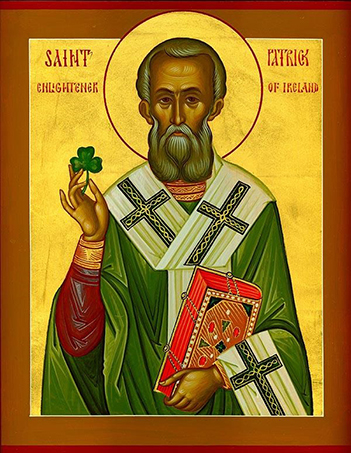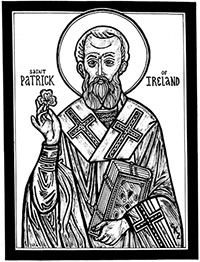St. Patrick, Enlightener of Ireland

Parades, wearing of the green, shamrocks, celebrations - which one of these is a true event in the life of St. Patrick? The humble bishop who helped establish Christianity in the country now known as Ireland would be surprised, and perhaps saddened, by some of the “traditions” associated with his missionary work during a challenging period in the life of the Church. A little-known fact is that Patrick was sent to Ireland twice, first against his will, and the second time following the will of God.
Patrick, was born and lived in the village of Bannavem Taberniae, in a part of Britain now known as Wales, around the year 385. This was the time when Christian missionaries were sent to many parts of Europe, and the Church was slowly working in the isolated islands of the British Isles. His parents were among the few Christians in Britain, where pagan gods were widely worshipped. Patrick's father, Calpurnis, was a deacon and a Roman county decurion (tax official), and his grandfather, Portitus, was a priest.
Patrick was not particularly religious or scholarly, but lived a quiet life. At the age of sixteen he was kidnapped by pirates from Ireland, who had been raiding the northern coast of Britain. He was taken to Ireland, sold as a slave, and spent six years working as a shepherd on a lonely mountain in Slemish, County Antrim. During this time Patrick not only learned the language of his captors, but used his solitude to find God and the faith of his youth, discovering that he was indeed not alone.

During his captivity, Patrick had two visions. In his first, he was told he would soon be returning home. His second vision called to him that his ship was waiting to take him home. Patrick walked two hundred miles, until he came to the coast and a ship preparing to set sail. At first he was refused entry, but as he turned away, the captain miraculously changed his mind. He suddenly called to Patrick and told him that he was allowed to board. The trip took several weeks, and at one point there was no food. The captain, knowing Patrick was a Christian, heckled the young man to pray to his God. Patrick did pray until, miraculously, a herd of pigs appeared and saved them from starvation. The ship then made way for Gaul (present day France.) Patrick wandered until he came upon the island of Lerins. There he studied for several years in a monastery, taught by monks including St. Vincent and St. Honoratus. Eventually returning home to his family, Patrick settled down to live quietly. This was not to last for long, for Patrick's second and final trip to Ireland was about to begin.
Soon Patrick had another vision in which an angel came to him bearing several letters. He opened one inscribed, "The Voice of the Irish," and heard the people who were once his captors calling him back to them.
Seeking further instruction, Patrick returned to Gaul, where he studied under St. Germanus of Auxerre. During his fourteen years there, he was ordained a priest and eventually consecrated a bishop. Bishop Patrick knew his mission was to return to Ireland and help to fully establish the Church in the pagan countryside.
Bishop Patrick knew he would be following other missionaries who had gone before him, including St. Palladius, who had spent a year in the harsh land, attempting to plants the seeds of Christianity, arguing with pagans, and correcting false versions of Christian doctrines which were spreading across the land. Patrick was one of several missionaries who arrived around 432.
The young bishop faced many disappointments and dangers as he endured hostility from people loyal to their pagan gods, especially a group known as Druids, pagan medicine men, who were suspicious of foreigners. Patrick worked through all of these obstacles, winning the approval of several kings and leaders, including the High-King Loigaire at Tara. He was able to convince people that the pagan leaders were not showing them the One True God. He confronted pagan priests with the truth, and one time actually toppled a pagan god's statue.
Never accepting gifts from kings or the wealthy, St. Patrick loved to talk to the common people, spending time with them and serving their spiritual and physical needs. Leprosy was an especially horrible disease of the skin and organs, leaving people terribly scarred and full of sores. Its victims were outcasts, compelled to live apart from others. The bishop embraced these suffering lepers, and invited them to live near him, so as to better minister to their needs. Often, he would go alone to Mt. Mis to meditate, pray, and fast for days at a time.
Bishop Patrick had to explain God and Christ's Holy Church in ways his simple people would understand. He used the three-leafed plant known as the shamrock, which grew in the emerald-green fields of Ireland, to illustrate the Holy Trinity to skeptical listeners. The three leaves, growing from a single stem, helped the Irish people see the mystery of the Holy Trinity.
Bishop Patrick tirelessly prayed and continued his work, establishing churches and monasteries, including his episcopal See in Armagh in 444. His writings include several letters and confessions. He worked with countless young people, and bravely denounced a leader who had enslaved some members of the Christian community. He is perhaps best known for defeating the pagan leaders, ordaining priests and bishops to serve his people, and baptizing thousands.
St. Patrick died on March 17, 461 (or 462), and was buried in an unknown location, by his own request. Tradition established by a later disciple, St. Columba of Iona, recorded that the beloved missionary was buried at Saul, the site of his first church. A granite monument was placed in Downpatrick, in 1899.
The humble bishop who is so widely celebrated with legends, parades, and merriment on his feast day considered himself a sinner and humble servant of Christ. His shamrock serves as a symbol of his loving desire to bring the people of Ireland to the One True God and His Holy Church.
Troparion (Tone 3)
Holy Bishop Patrick faithful shepherd of the Christ’s royal flock, you filled Ireland with the radiance of the Gospel: the mighty strength of the Trinity! Now that you stand before the Savior, pray that He may preserve us in faith and love!
Kontakion (Tone 3)
From slavery you escaped to freedom in Christ’s service: He sent you to deliver Ireland from the devil's bondage. You planted the Word of the Gospel in pagan hearts. In your journeys and hardships you rivaled the Apostle Paul! Having received the reward for your labors in heaven, never cease to pray for the flock you have gathered on earth, Holy Bishop Patrick!
Copyright © Department of Christian Education - Orthodox Church in America.